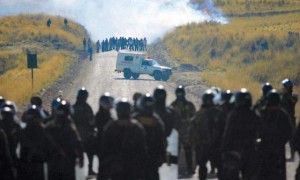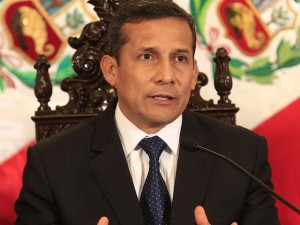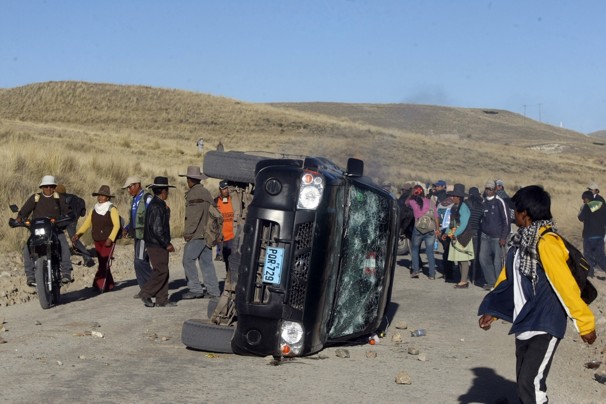Corporations and Campesinos Clash Again in Peru: An Update
Please note: This article has been updated since publication on Thursday, May 31st.
Peru, like many other Latin American countries, is heavily dependent upon revenue generated through such extractive industries as copper, gold, and silver mining. Indeed, the mining of precious metals and minerals accounts for more than 60 percent of Peru’s total export income. While the development of the Peruvian mining sector has enabled robust growth for the country’s economy, it has also been the cause of repeated frictions between the Peruvian indigenous population and Lima, which is widely seen as being complicit in rights violations perpetrated by mainly overseas mining corporations.
The constant struggle between foreign mining corporations and indigenous peoples culminated in violent protests over the weekend of May 26th and 27th. The Quechua indigenous population of the heavily mestizo city of Cusco, located in the province of Espinar, is demanding reparations and increased corporate accountability from Xstrata, the Swiss multinational that owns the region’s Tintaya copper mine. Protestors say that Tintaya management has brought about water contamination in at least two local rivers—the Salado and Canipia—leading to the deaths of farm animals. Last August, the local Roman Catholic diocese conducted an environmental study that reportedly found high levels of arsenic, copper, mercury, and other heavy metals in a number of soil and water samples, confirming the aforementioned accusations. Xstrata categorically denies all responsibility for any such pollution.(1) The protesters are calling upon Xstrata to conduct additional environmental studies regarding the impact of Tintaya on the local environment(2) and to increase its “voluntary contribution” to Espinar province from 3 percent of pre-tax profits (roughly USD 11 million per year) to 30 percent of pre-tax profits.(3) Thus far, Xstrata has rejected both demands, citing a lack of definitive evidence linking its mining operations to the pollution of local habitats, and claiming that its voluntary contributions are already very generous.

The Protest and the Government’s Response
Last week, protesters comprised of 1,500 striking miners and indignant townspeople, and led by Espinar Mayor Oscar Mollohuanca Cruz (4), erected a blockade of boulders and tree trunks on the main road to the mine. On Monday, May 28th, however, a company executive claimed that the mine had been able to function normally despite the blockade.(3) Reports suggest that the protests were peaceful until May 27th, when protesters threw rocks at policemen and set fire to pastures adjacent to the main road. Protesters also briefly detained a local public official captive on the 28th after overturning his car and setting it on fire. An estimated 30 police officers were injured in the protests, while two protesters were killed and at least 30 more sustained injuries when police fired teargas into the amassed crowd. Police officials claim that the militant response was purely self-defense, and Prime Minister Oscar Valdés, a former military officer, issued a statement supporting the use of violence in response to the protests.(1)
According to official reports, President Ollanta Humala’s cabinet has called upon the Peruvian military to support the national police force in its efforts to regain control of the situation in Espinar, and to maintain a sense of security throughout the region. The government stressed that armed forces were deployed to regain peace, and commanded not to act unless provoked by extreme cases of civil disturbance.
The Peruvian government also declared a 30-day state of emergency in Cusco on May 28th. The announcement was made via the national news source, El Peruano, and consists of a complete suspension of constitutional rights, including those of assembly and transit.(5) This is the second 30-day state of emergency enacted by the Peruvian government within the last six months, the previous occurring in the province of Cajamarca in response to comparable protests against the USD 4.8 billion Conga Gold mining project, the largest investment in Peru to date.(1) Concerning the local population’s environmental concerns over Tintaya, Prime Minister Valdes has stated that the government perceives them to be exaggerated and therefore invalid.
The protest continued on May 29th, and 24 civilians were detained for violating the conditions of the state of emergency.(6) The situation escalated on Wednesday, May 30th, with the arrest of the mayor of Cusco, Oscar Mollohuanca, for inciting a continuation of the protest and commending the campesinos for their stand.(7) The president of Espinar, Jorge Acurio, says there is no possibility of negotiating a settlement while the mayor is held captive. In response to the detention, Congressman Ruben Coa, a representative of the Espinar region and member of President Humala’s Gana Peru political party, has publicly requested the resignation of Prime Minister Valdés.(7)
The government defends its authoritarian response, referring to protesters as “radicalists” and “extremists.” Jorge Merino, the Peruvian prime minister of Mines and Energy, went so far as to claim that the protest was being led by “political groups with their own agenda,” insinuating that the demands of the people are neither valid nor worth the government’s attention.(8) The administration’s firm action against the social movement serves as just one example, among many, of President Humala’s increasing reliance on overtly conservative policies, breaking from the leftist platform he championed during his presidential campaign.
Corporate Response
Despite the local protests, Xstrata claims that it remains committed to future investments in the country, particularly a USD 1.5 billion expansion project of the Tintaya mine scheduled for late August. In an official statement issued on May 28th, a spokesperson for Xstrata claimed that the company is willing to work through local and national authorities to engage in an open dialogue with local citizens, and will consider increasing the 3 percent donation to local development. While the corporation claims to be following appropriate environmental regulations, Xstrata says it will increase monitoring efforts in order “to clarify any perceptions or concerns that the population may have.”(2)
History of the Espinar Mine
Conflict surrounding the Tintaya mine has been constant since its establishment in 1985. The government initially acquired the land for the mine from local citizens, paying a paltry USD 3 per 2.45 acres, whereupon the mine was state-owned until its subsequent privatization in 1994. Currently, the community owns just 1 percent of the land surrounding the mines. In initial appeals to local landowners, the government promised mining jobs for the entire community; more than 25 years later, the government has yet to make good on its promise of employment, and the community awaits economic benefits stemming from the local mining operation.(8) By the late 1990s, numerous protests had erupted in response to several factors, the most prominent being the mine’s adverse impact on the environment, such as waste water leaking into local water sources, contaminating pastures and rendering local water supplies unfit for human and animal consumption. Furthermore, complaints about human rights violations have surfaced, including forced evictions, as well as incidents of rape and other physical abuse. Finally, local dissatisfaction with the mining project resulted from a growing perception among the local population that they were being denied their fair share of the economic benefits accruing from the project.
Following the repeated outbreak of protests against the Tintaya mine throughout the 1990s, a “Dialogue Table,” consisting of all parties involved in the protests, was formed to facilitate communication and enable collaborative resolution of the issues raised by the community regarding the mine. The Dialogue Table, a permanent mechanism since 2004, consists of local NGOs (such as CONACAMI and CooperAcción), international NGOs (such as Oxfam America and Oxfam Australia), and the mine owner, Xstrata (formerly BHP Billiton). In light of the current protests, it appears that the Dialogue Table has failed to address grievances of transcendent importance concerning persistent environmental abuses and chronic instances of underdevelopment.
Developments
Since May 31st, similar protests have developed in Peru’s northern region of Cajamarca, where Newmont Mining Corporation operates the Conga project, involving surface mining of both gold and copper deposits. While Newmont, a U.S.-based conglomerate, maintains control of mining projects around the world, its operation at Conga alone generates profits of USD 4.8 billion annually. Leading the protests in Cajamarca is Regional President Gregorio Santos, who has publicly called for a removal of President Humala from office. Santos reportedly asked the crowd, “What happens to a president who does not honor his words or … his commitments?” To which the crowd responded, “He is removed.”(10) While the Congress of the Republic of Peru severely criticized Santos, claiming he is guilty of “incitement to the crime of rebellion,” Santos’ query is justified in light of Humala’s campaign promises to redistribute natural-resource wealth and create a more equitable social environment in Peru.(11)

Political Outlook
Humala’s authoritarian approach to forcibly bring an end to the current protest proves that the administration is now more concerned with cultivating a booming economy than protecting the rights of its people. Humala’s increasingly centrist principles resemble those of former President Lula da Silva of Brazil. Lula’s political stance became consistently centrist throughout his presidency, particularly when dealing with populist impulses of other leftist leaders within South America, including Chavéz of Venezuela and Morales of Bolivia. While Lula cultivated Brazil’s economic growth through centrist policies that imposed little regulation on financial markets, he also implemented and strengthened numerous social programs, thereby attempting to balance economic growth and social well-being.(9) In order to toe this politically attractive line, it is likely that Humala will follow the example set by Lula and continue to promote centrist policies, at the detriment of the indigenous communities of Peru. The Tintaya protest is a clear sign that significant dissatisfaction exists among the local population, rooted in the administration’s failure to ensure that the economic success of the mine trickles down to the surrounding community.
Furthermore, even if he may not desire to be a centrist leader, Humala may have little choice. In response to the protests occurring throughout Peru, three members of Gana Peru in the Congress have resigned, leaving the leftist political party with just 43 of 130 seats in the legislature. To date, Humala has relied upon the support of the 20 Perú Posible congressmen in order to achieve a functional legislative plurality. However, as these resignations have narrowed the gap between the opposing Gana Peru and Fuerza 2011 parties, Humala’s policies will likely be forced to take a notable shift to the right. Whether he likes it or not, in order to respond to the public’s demands for legislative reform, Humala will find himself having to reach across the aisle to members of the conservative Fuerza 2011. Moreover, political analyst Fernando Tuesta predicts that more lawmakers will likely leave the ruling Gana Peru Party if these persistent social conflicts are not given the attention they appropriately deserve, spelling further concerns for the Humala administation.(11)
Conclusion
The Tintaya mine has been a source of tension between the local population and the owners of the mine since its establishment, and a consensus between these actors is long overdue. In order to protect the rights of the local population and ensure that a portion of the profits of the mining industry benefits the community, and not simply the corporation and its shareholders, several basic policy changes should be enacted by both the Peruvian government and Xstrata.
First, Xstrata needs to address the issue of water contamination by commissioning an outside, unbiased organization to conduct environmental research in the area so as to determine the environmental effects of the mine. Although Xstrata claims to adhere to regulations, such claims do not necessarily indicate that the mine is not causing the documented water contamination.
Admittedly, USD 11 million is no small sum. However, despite the copper mine’s continued success, many citizens in the area are still living in dire poverty and face adverse health conditions on a daily basis. While the protesters’ call for an increase in Xstrata’s financial contributions is valid, it is also absolutely necessary that there be an increase in transparency regarding how the local government is utilizing current contributions. A clear outline stating how current donations are being used and how the increased funds will be implemented to benefit the people of Espinar province should be made available to the public by the provincial government.
Finally, the people of Espinar have the right to not only be free from the negative impacts of copper mining, but to also enjoy a share in the economic benefits of the booming Tintaya mine. Although the Espinar protesters were forced to resort to radical means for their voices to be heard, their demands are far from extreme. In the future, increased collaboration between both international and local actors is necessary to satisfy local demands and enable the long-term sustainability of the project. Such a dialogue should occur within the Dialogue Table or, if the forum proves to be defunct, a revitalized version of it.
Ongoing clashes between the indigenous peoples of Peru and the Peruvian state over mining operations reflect a status quo nearly ubiquitous in Latin America. Environmental and social harms inflicted on local communities by foreign-owned corporations have led to recent protests in Argentina, Chile, Ecuador, and now Peru.(12) While the exploitation of Latin America’s natural resources is driven, according to state leaders, by an altruistic desire to rapidly eradicate poverty, as well as stimulate economic and social development, the current pillaging of Latin America has demonstrated an inability to generate these desired results and must not be allowed to continue unquestioned.
To view citations, click here.
Please accept this article as a free contribution from COHA, but if re-posting, please afford authorial and institutional attribution. Exclusive rights can be negotiated.


